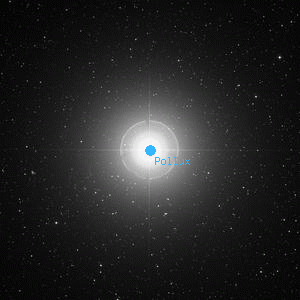Pollux

Overlaid DSS image of Pollux, 60' x 60' with north at top and west to the right
Aladin viewer for the region around Pollux
Beta Geminorum, β Gem, 78 Gem
BD+28 1463, HD 62509, HR 2990, WDS J07453+2802A, SAO 79666, HIP 37826
BD+28 1463, HD 62509, HR 2990, WDS J07453+2802A, SAO 79666, HIP 37826
| Type | Star |
|---|---|
| Magnitude | 1.14 | Right Ascension | 7h 45' 19.0" (2000) |
| Declination | 28° 1' 34" N |
| Constellation | Gemini |
| Classification | K0IIIb |
Observing Notes
Andrew Cooper
Feb 19, 2020 Waikoloa, HI (map)
20cm f/6 Newtonian, Cave Astrola @ 61x
Seeing: 7 Transparency: 6 Moon: 0%
Brilliant yellow, no companion noted
Captain William Henry Smyth
Apr 23, 1832 No. 6 The Crescent, Bedford, England (map)
150mm f/17.6 refractor by Tully 1827
sA standard Greenwich star coarsely triple, or rather quadruple, in the eye of Pollux. A 2, orange tinge; B 12½, ash-coloured; C 11½, pale violet, and it has a minute comes to the sp, which, though unnoticed in former registers, is certainly now (1832) as bright as C: these companions form a neat triangle*. This wide object is 42 ♅. VI., but at its first registry the two nearest only were measured:Pos. 65° 32' Dist. 116".80 Ep. 1783.20But Sir James South included the distant star, and made it triple; and by altering his uncial letters so that B becomes the nearest to the principal, according to the rule which I have adopted, the measures he obtained will stand thus:Pos. AB 66° 23' Dist. 132".31 | Ep. 1825.10This star has been suspected of varying in lustre, since it is recorded as having at times been brighter than Castor, whence Bradley rated it of the 1st magnitude; others have classed it in the 3rd rank; but Ptolemy, Tycho, La Caille, Zach, and all the best authorities, classify it 2. Nor is this the only anomaly of Pollux, for the ancients represented it in colour υποκιρρος, subrufa, reddish; Lichtenstein says, Qnæ trahit ad æram, et est cerea; and certainly, in 1832, its tint was as I have mentioned, under an eyepiece magnifying 240 times. It has a considerable proper motion, the amount of which has been thus assigned:
AC 72° 40' 198".47 |
[WDS AC 76° 257".50 2013 (was AB)]
[ AF 79° 313".50 2013 (was AC)]P.... RA -0".72 Dec. -0".llThis star is well known as Pollux, the brother of Castor; but in the Alphonsine Tables, and in other old astronomical works, it is called Ras-al-geuze, the twin's head, from the doubtful word jauzá or júzá. It was, however, better known among the later Arabians as Rás-al-tarvum al muäkhkhar, the head of the hindmost twin; and the two heads form the VIIth Lunar Mansion, in the Arabian constellation al-dhirá' al-mebsútah. See δ Geminorum. Pollux may generally be known by his connection with Castor; but for further identity, a line drawn from the Pleiades through Nath on the Bull's horn, passes to it; as will also a line from Rigel between ε and ζ Orionis, the two last stars of the belt. Having found it, the brackish rhymes tell us:
B.... -0".66 -0".06
A.... -0".71 -0".06
[Hipparcos -0".62655 -0".04580]If Betelgeuze and Procyon with Pollux bright be cast,* While this is in the press, the Rev. W. R. Dawes has shown me an exact diagram which he made of this object, January 1, 1829, with a 3½-foot achromatic, charged with a Huygenian eye-piece magnifying 200 times. With this instrument he saw the three companions very distinctly, although two only were visible, and that but on remarkably fine nights, in Sir James South's 7-foot cquatoreal, with an aperture of 5 inches.
Amid the glories of the sky, shines a triangle vast;
To gauge with practised studious eye the form that shines afar
The angle of twice forty-five, shows 'tis rectangular.― A Cycle of Celestial Objects Vol II, The Bedford Catalogue, William Henry Smyth, 1844
Other Data Sources for Pollux
Nearby objects for Pollux
8 objects found within 120'
| IC 2205 | IC 2208 | IC 474 |
| IC 476 | NGC 2449 | NGC 2450 |
| NGC 2467 | Sigma Geminorum |
Credits...
Drawings, descriptions, and CCD photos are copyright Andrew Cooper unless otherwise noted, no usage without permission.
A complete list of credits and sources can be found on the about page
Pollux